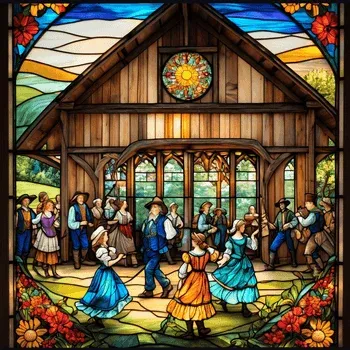BY CHARLES MORRIS
The Fatal Expedition of Colonel Rogers
Historical Tales 2 American: Story 15 of 34

Heading

Purpose of the Expedition: The primary objective of Colonel David Rogers' expedition in 1778 was to secure much-needed ammunition, including gunpowder and cannonballs, from New Orleans to aid the American forces during the Revolutionary War.
Legacy of the Expedition: The tragic end of Colonel Rogers' expedition highlights the constant dangers faced by early American forces during the Revolutionary War and underscores the challenges of securing and transporting vital supplies over long distances and through hostile territory.
A good book we like, we explorers. That is our best amusement, and our best time killer
- Roald Amundsen, Explorer
Colonel David Rogers: A Mission of Ammunition in the American Revolution
The riveting tale of Colonel David Rogers, an unsung hero of the American Revolution, whose mission of ammunition from New Orleans was a journey fraught with danger and unexpected twists. This epic odyssey reveals the harsh realities of warfare, the unyielding spirit of our forefathers, and the high cost of our nation's birthright. Learn how this event shaped the course of the Revolution and why it remains a significant piece of American history. The details of this extraordinary expedition, its triumphant moments, and tragic turn of events, await you.
Setting Off from the Old Red Stone Fort: The Start of a Crucial Mission
In the heart of the American Revolution, a task of paramount importance was assigned to Colonel David Rogers, a man of undaunted courage and unwavering resolve. His mission was a demanding one, to secure a shipment of much-needed ammunition from New Orleans. Rogers, along with a brave company of 40 men, embarked on their incredible journey from their base at the Old Red Stone Fort, nestled by the Monongahela River. The task was not just a test of their strength, but also of their alertness, for they had to navigate through hostile territories, under the constant threat of native attacks. Their first major milestone was to reach the mouth of the Ohio River and veer into the Mississippi.
Encounter at the Spanish Fort: A Change in Plans
Rogers and his men, upon reaching a Spanish fort at the mouth of the Arkansas River, were met with unexpected news. The ammunition that they had been tasked to retrieve had been relocated to a fort closer to the present-day location of St. Louis. Despite this change, Rogers was determined to carry on to New Orleans to obtain an order from the Spanish governor. The change in the original plan represented a new challenge, but it was one that Rogers was ready to face head-on.
Podcast
The Journey to New Orleans: A Test of Will and Endurance
Traveling to New Orleans was no easy task. Upon reaching the city and obtaining the order from the Spanish governor, Rogers and his men faced a great difficulty - the swift currents of the Mississippi River. To overcome this obstacle, they made the challenging decision to travel by land. Despite the hardships, the men reunited at the Spanish fort and, fuelled by their steadfast determination, they were ready to set off once again. Their journey was a testament to their will and endurance, a testament to the spirit of the Revolution.
Return and Retrieval: The Pursuit for Ammunition at Fort St. Louis
Once in New Orleans, Colonel David Rogers received an order from the Spanish governor, allowing him to retrieve the ammunition from the fort near the present-day location of St. Louis. However, the journey upstream was not an easy one due to the swift currents of the Mississippi River, making it difficult for the party to navigate. These challenges necessitated a change in plan, the group decided to travel by land.
Reuniting with the rest of his men at the Spanish fort, they set off again. This time their destination was Fort St. Louis, where the ammunition was being stored. The journey was long and arduous, but the group's morale was high, driven by the importance of their mission. After what felt like an eternity, they finally reached Fort St. Louis. The much-needed ammunition was delivered into their hands, filling them with joy and a renewed sense of hope.

The Unfortunate Ambush: A Tragic Turn of Events
Filled with hope and a sense of accomplishment, the group, led by Rogers, began their journey back home. As they neared the future site of Cincinnati, they were lured ashore by a small party of Indians. Unbeknownst to them, a larger group was waiting in ambush. A brutal battle ensued, during which Rogers was fatally wounded. The surviving men had no choice but to flee into the forest, leaving the precious ammunition behind.
The Loss of Rogers and the Future of the American Revolution
The loss of Rogers was a profound blow, not just to the men who survived, but to the cause of the American Revolution. Of the original party of 40, only thirteen men made it to a settlement on the Kanawha River in Virginia. The ammunition they had fought so hard to obtain, fell into the hands of the Indians. It is believed that these munitions were later used against the Americans in the ongoing war.
The loss of Rogers and the ammunition was a grave setback. However, the spirit of the revolution was not easily quelled. The sacrifice of Rogers and his men served to strengthen the resolve of those who believed in the cause, reminding them of the cost of freedom and the price they were willing to pay for it.
Conclusion
In the tragic tale of Colonel David Rogers, we witness the reality of warfare - fraught with uncertainty, danger, and sacrifice. His arduous journey for ammunition, although ultimately unsuccessful, symbolizes the relentless spirit of our forefathers. The loss of Rogers and his men near future Cincinnati serves as a stark reminder of the high price paid for our nation's birthright. This historic odyssey, though less known, significantly influenced the course of the American Revolution, underscoring the complexities of our nation's fight for independence.





